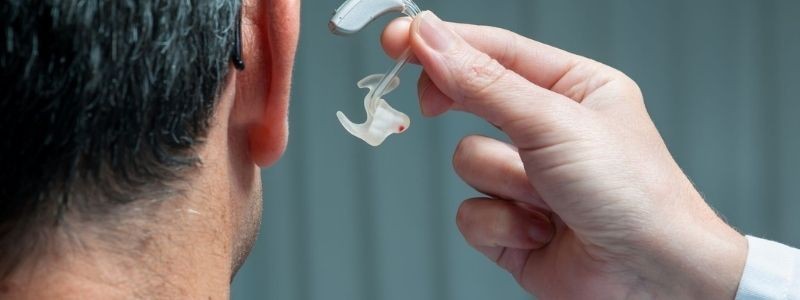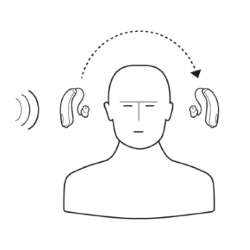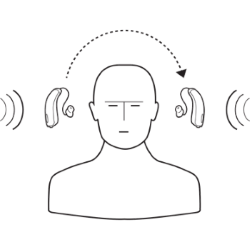CROS Hearing Solution BiCROS Hearing Solution
CROS Hearing Aids and BiCROS Hearing Aids
Single-sided deafness hearing loss solutions
| Hearing Aid UK 08/01/2026 Update |
What is single-sided deafness?
Single-sided deafness means you have one ear that is deaf and one ear with ‘normal’ hearing. This also applies to those who have one deaf ear and one who has hearing loss, which can be improved by wearing a digital hearing aid. This is also called unilateral hearing loss.
Some individuals can not hear much in one ear to such an extent that a standard hearing aid won't support them. Unfortunately, some people with single-sided deafness live with it by asking people to communicate with them on their good side or their 'good' ear.
This isn't an ideal solution and means that they will still find it a challenge to hear in noisy environments as well as locate the direction of the sound they hear.
Now, there are various successful hearing aid solutions that cater to single-sided deafness, such as CROS and BiCROS hearing aids. We go into more detail about these latest models introduced into the industry further down the page.
How does a CROS hearing aid compare to a generic hearing aid?
Generic hearing aids direct sound into the ear they are placed on. With a CROS hearing solution, the device on the poor ear side looks like a generic hearing aid, but actually, it is a transmitter and microphone that picks up the sound to direct it to the device on the good side or ear that can hear.
What is a CROS hearing aid, and what is a BiCROS hearing aid?
So, what are CROS and BiCROS hearing aids - how do they work? There are two separate hearing aid solutions for single-sided deafnes,s and these are called CROS hearing aids and BICROS hearing aids. Here is the breakdown:
BiCROS hearing aids meaning
What is a BiCROS hearing aid? A BiCROS hearing aid is for people who have one deaf ear and one ear with hearing loss. The abbreviation stands for Bilateral with Contra-lateral Routing of Signal.
BiCROS (bilateral contralateral routing of signals) hearing aids are a type of hearing device that is used to improve hearing in individuals with asymmetrical hearing loss or single-sided deafness (SSD).
Asymmetrical hearing loss refers to a condition where an individual has a significant difference in hearing ability between the two ears.
SSD is a condition in which an individual has normal or near-normal hearing in one ear, but severe to profound hearing loss in the other ear.
You wear them in both ears
BICROS hearing aids are similar to traditional hearing aids in that they are worn in both ears. However, the hearing aid in the poorer hearing ear is equipped with a microphone.
This picks up sounds from that ear and transmits them wirelessly to the hearing aid in the better-hearing ear. This allows the individual to hear sounds from both ears, even if one ear is not functioning properly.
CROS hearing aids meaning
What is a CROS hearing aid? A CROS hearing aid is for people with one deaf ear and one good ear. The abbreviation stands for Contra-lateral Routing of Signal.
Cross hearing aids, also known as CROS or contralateral routing of signals hearing aids, are devices that are used to improve hearing in individuals with single-sided deafness (SSD) or asymmetrical hearing loss. With SSD, an individual has normal or near-normal hearing in one ear, but severe to profound hearing loss in the other ear.
Asymmetrical hearing loss
Asymmetrical hearing loss refers to a condition where an individual has a significant difference in hearing ability between the two ears.
CROS hearing aids are designed to pick up sounds from the poorer-hearing ear and transmit them wirelessly to a hearing aid in the better-hearing ear. This allows the individual to hear sounds from both sides of their body and improves their ability to locate the source of a sound.
CROS hearing aids can be particularly helpful for individuals who have difficulty hearing in noisy environments, as they allow the individual to hear sounds from both sides of their body, which can improve their ability to focus on a conversation or other important sounds.
They can also be helpful for individuals who have trouble understanding speech when only one ear is functioning properly, as the CROS hearing aid allows them to hear sounds from both ears.

CROS Hearing Aids and BiCROS Hearing Aids
If you are deaf in one ear, what does that mean for you?
What are your challenges?
For those who are deaf in one ear, there are a few challenges. For example, following conversations (also known as the Head Shadow Effect) is a challenge because of the different sound frequencies we hear.
For instance, low-frequency sounds are shorter in wavelength (which can go around the head) and high-frequency sounds are shorter (which are blocked by the head).
Therefore, it makes it extremely difficult for those with a deaf ear to follow the conversation, without having to turn their head. The direction of sound is also tricky, as having one good ear makes it very hard to know which direction sounds are coming from.
What does a CROS hearing aid do?
So, how do CROS hearing aids work? In brief, in a CROS system, you wear hearing aids in both ears – even though you can’t hear in one ear. This means the sound detected by the hearing aid in the bad ear is transmitted straight to the aid in the good ear. This eliminates the ‘head shadow’ effect.
What does a BiCROS hearing aid do?
So, how do BiCROS hearing aids work? In short, these work in a similar way to the CROS system, except that they are designed for those who have a hearing loss in their good ear, too.
Your audiologist will also programme the hearing aid in your good ear for any amplification you may need.

CROS Hearing Aids and BiCROS Hearing Aids
CROS and BiCROS hearing aid prices
So, what hearing aid manufacturers offer these types of hearing loss solutions? The short answer here is that most of the main hearing aid brands do have these hearing solutions in their product portfolio. Usually, both these types of hearing aids start from around £795.
Here are the ones we have available and what we believe to be the best CROS/BiCROS hearing aids on the current market. Click on the products below to find out more and to view our CROS/BiCROS hearing aid prices.
Getting used to CROS or BiCROS hearing aids takes time
CROS and BiCROS hearing aids, like other hearing aids, take time to adjust and get used to. As simple as it sounds, you need to wear your CROS hearing aid everyday or as much as possible and not give up when it feels challenging.
Your local audiologist is there for any program adjustments and support when needed, so you benefit from the best hearing experience possible.
NHS CROS hearing aids and BiCROS hearing aids
Can you get CROS or BICROS hearing aids from the NHS? Yes, you can, however, like other hearing aids the choice and technology will be limited. You can make an appointment with your local NHS service and be assessed to determine whether a CROS or BICROS hearing aid solution is right for you.
What are the benefits of CROS or BICROS hearing aids?
- You will be able to hear sounds from both sides without having to turn your head.
- You will be less likely to miss a conversation due to your poor hearing side.
- You will feel less 'cut off' on your bad hearing side.
- In quiet hearing situations and good room acoustics, this solution should be of benefit.
Conclusion
With CROS and BiCROS hearing aids, there can be some latency (delay) in the transmission of sound from the poorer-hearing ear to the better-hearing ear, which can be jarring for some users.
But, overall, CROS hearing aids can be a useful tool for individuals with single-sided deafness or asymmetrical hearing loss, allowing them to hear sounds from both sides of their body and improving their ability to locate the source of a sound.
However, it is important for individuals to discuss the potential benefits and drawbacks of CROS hearing aids with a hearing healthcare professional before making a decision about whether or not to use them.
Want more information on CROS or BiCROS hearing aids?
There are many benefits to CROS and BiCROS hearing aids such as feeling less cut off on your bad hearing side. Discover what solutions could help you and your hearing loss, by calling us free on 0800 567 7621 to speak with one of our audiologists.
We can support you locally
We have over 200 audiologists nationwide, so we can support and look after your hearing health in your area.
Other Hearing Aid Styles Below
Our specialist service includes:
Do not spend hundreds of pounds without getting a second opinion from us.
Please call us on 0800 567 7621
 Not only are the prices great, but the service is fantastic! Many thanks to your team.
Not only are the prices great, but the service is fantastic! Many thanks to your team.Watch the Phonak CROS hearing aid video below
What's included in our hearing aid prices?
Other pages you might find useful
Common FAQs about CROS and BICROS hearing aids
In general, any audiologist will always recommend to you the hearing aid model that best suits your needs. Here is a useful checklist to make sure that is the case.
- Audiologist's level of knowledge: The audiologist you have seen will hopefully have a wide knowledge of all available hearing aids; however, some will only be familiar with a small number of brands and, therefore, may not really be in a position to know which model is the best for you. It is OK to challenge their recommendation and ask them to justify why this particular brand is the one for you.
- Do research: Read about the hearing aid that was recommended. Does it seem like it will suit your lifestyle? Does it have more or fewer features than you need?
- Be aware of sales targets: Many high street retailers have specific tie-ins to a particular manufacturer/brand. The hearing aid they have suggested may still be the correct one for you, but do your research so that you know why they might have recommended it.
If you have significant hearing loss in both ears, you should be wearing two hearing aids. Here are the audiological reasons why:
Localisation: The brain decodes information from both ears and compares and contrasts them. By analysing the minuscule time delays as well as the difference in the loudness of each sound reaching the ears, the person is able to accurately locate a sound source.
Simply put, if you have better hearing on one side than the other, you can't accurately tell what direction sounds are coming from.
Less amplification is required: A phenomenon known as “binaural summation” means that the hearing aids can be set at a lower and more natural volume setting than if you wore only one hearing aid.
Head shadow effect: High frequencies, the part of your hearing that gives clarity and meaning to speech sounds, cannot bend around your head. Only low frequencies can. Therefore, if someone is talking on your unaided side, you are likely to hear that they are speaking, but be unable to tell what they have said.
Noise reduction: The brain has its own built-in noise reduction, which is only really effective when it is receiving information from both ears. If only one ear is aided, even with the best hearing aid in the world, it will be difficult for you to hear in background noise as your brain is trying to retain all of the sounds (including background noise) rather than filtering them out.
Sound quality: We are designed to hear in stereo. Only hearing from one side sounds a lot less natural to us.
Fancy some further reading on this topic? You can read about why two hearing aids are better than one in our article, hearing aids for Both Ears, here
For most people, the main benefit of a rechargeable hearing aid is simple convenience. We are used to plugging in our phones and other devices overnight for them to charge up. Here are some other pros and cons:
For anybody with poor dexterity or issues with their fingers, having a rechargeable aid makes a huge difference, as normal hearing aid batteries are quite small and some people find them fiddly to change.
One downside is that if you forget to charge your hearing aid, then it is a problem that can't be instantly fixed. For most, a 30-minute charge will get you at least two or three hours of hearing, but if you are the type of person who is likely to forget to plug them in regularly, then you're probably better off with standard batteries.
Rechargeable aids are also a little bit bigger and are only available in Behind-the-Ear models.
Finally, just like with a mobile phone, the amount of charge you get on day one is not going to be the same as you get a few years down the line. Be sure to ask what the policy is with the manufacturer's warranty when it comes to replacing the battery.
For most people, the answer is yes. But it's never that simple.
The majority of hearing problems affect the high frequencies a lot more than the low ones. Therefore, open fitting hearing aids sound a lot more natural and ones that block your ears up can make your own voice sound like you are talking with your head in a bucket. Therefore, in-ear aids tend to be less natural.
However, the true answer is we can't tell until we have had a look in your ears to assess the size of your ear canal, and until we have tested your hearing to see which frequencies are being affected.
People with wider ear canals tend to have more flexibility, also there are open fitting modular CIC hearing aids now that do not block your ears.
There is also the age-old rule to consider, that a hearing aid will not help you if it's sat in the drawer gathering dust. If the only hearing aid you would be happy wearing is one that people can't see, then that's what you should get.
Most people can adapt to any type of hearing aid, as long as they know what to expect. Have an honest conversation with your audiologist as to what your needs are.
Generally speaking, six or more. Unless it's none at all. The number of channels a hearing aid has is often a simplistic way an audiologist will use to explain why one hearing aid is better than another, but channels are complex, and it is really not that straightforward. Here are some reasons why:
Hearing aids amplify sounds of different frequencies by different amounts. Most people have lost more high frequencies than low, and therefore need more amplification in the high frequencies. The range of sounds you hear is split into frequency bands or channels, and the hearing aids are set to provide the right amount of hearing at each frequency level.
Less than six channels, and this cannot be done with much accuracy, so six is the magic number. However, a six-channel aid is typically very basic with few other features and is suitable only for hearing a single speaker in a quiet room. The number of channels is not what you should be looking at; it's more the rest of the technology that comes with them.
As a final note, different manufacturers have different approaches. One method is not necessarily better than any other. For example, some manufacturers have as many as 64 channels in their top aids. Most tend to have between 17 and 20. One manufacturer has no channels at all.
Manufacturer's warranties typically last between 2-5 years, depending on the brand and model, and cover defects in materials and workmanship. This includes repairs for component failures, electronic malfunctions, and manufacturing defects, but excludes damage from misuse, accidents, or normal wear. Most manufacturers also include loss and damage insurance for the first year.
We handle all warranty claims on your behalf, liaising with manufacturers and ensuring you get replacement devices quickly when needed. This comprehensive warranty coverage, combined with our lifetime aftercare, gives you complete peace of mind.
Our hearing tests are completely free, whether at our clinics or in your home. Unlike other providers who charge £30-£100 for home visits, we believe hearing healthcare should be accessible without financial barriers. Our comprehensive assessments include examination by a registered audiologist, audiogram results, and personalised recommendations.
All testing, future adjustments, and ongoing support are included at no extra cost. While NHS tests are also free, typical 6-week waiting periods often lead people to seek immediate private testing. We provide prompt, professional assessments that fit your schedule and budget.
Yes, we offer completely free home visits throughout the UK, and this service is included in our prices with no additional charges. Home visits are particularly valuable for people with mobility issues, busy schedules, or those who simply prefer the comfort and convenience of their own environment.
Our audiologists can conduct full hearing tests, fit hearing aids, and provide ongoing support in your home. This service sets us apart from many providers who either don't offer home visits or charge extra for them.
We can offer prices up to 40% lower than high street retailers because of our business model. As a network of 200+ independent audiologists, we don't have the massive overheads of large retail chains - no expensive high street premises, no sales targets pushing audiologists to sell the most expensive options, and no costly marketing campaigns.
However, we maintain the same buying power as the big chains because we purchase on behalf of our entire nationwide network. This means you get access to the same premium hearing aids with professional service, but at genuinely competitive prices.
We offer a comprehensive 60-day money-back guarantee, which gives you twice the industry standard time to properly assess whether your hearing aids are right for you. This extended period recognises that adjusting to hearing aids takes time, and your brain needs several weeks to adapt to the amplified sounds.
Unlike many providers who offer just 30 days, we believe 60 days gives you the confidence to test your hearing aids in all the situations that matter to you - from quiet conversations at home to busy restaurants and outdoor activities.
Ask the Experts
6 Morton Lane
Walkwood
Redditch
Worcestershire
B97 5QA
Latest Launch
When we refer to a product as 'Latest Launch', we mean it is the latest to be released on the market.
New
When we refer to a product as 'New', we mean that the product is the newest hearing aid model on the market.
When we refer to a product as 'Superseded', we mean that there is a newer range available which replaces and improves on this product.
Older Model
When we refer to a product as an 'Older Model', we mean that it is has been superseded by at least two more recent hearing aid ranges.


